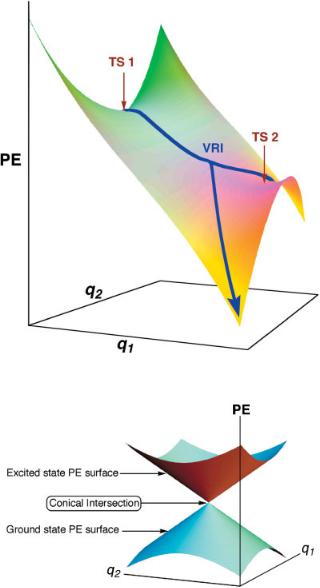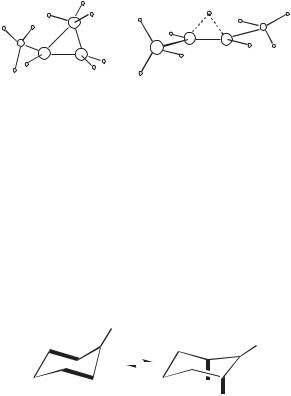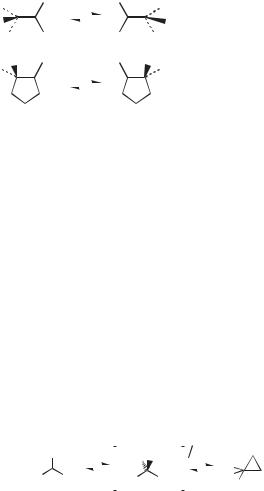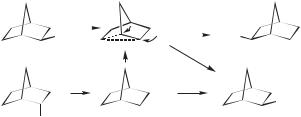
Reactive Intermediate Chemistry
.pdf
Figure 21.3. A schematic PE surface possessing a VRI point.
Figure 21.5. A schematic representation of a conical intersection between two electronic states of a molecule. Coordinates q1 and q2 are the nonadiabatic coupling vector and the gradient difference vector, along which the degeneracy between the states is lifted.

 PART 1
PART 1
REACTIVE INTERMEDIATES

CHAPTER 1 |
|
Carbocations |
|
ROBERT A. McCLELLAND |
|
Department of Chemistry, University of Toronto, Toronto, Ontario M5S 3H6, Canada |
|
1. Historical Perspective . . . . . . . . . . . . . . . . . . . . . . . . . . . . . . . . . . . . . . . . . . . |
4 |
1.1. Definitions . . . . . . . . . . . . . . . . . . . . . . . . . . . . . . . . . . . . . . . . . . . . . . . |
4 |
1.2. Early Studies. . . . . . . . . . . . . . . . . . . . . . . . . . . . . . . . . . . . . . . . . . . . . . |
4 |
1.3. Carbocations as Reactive Intermediates . . . . . . . . . . . . . . . . . . . . . . . . . . . |
4 |
2. Persistent Carbocations under Stable Ion Conditions. . . . . . . . . . . . . . . . . . . . . . |
5 |
2.1. Superacids . . . . . . . . . . . . . . . . . . . . . . . . . . . . . . . . . . . . . . . . . . . . . . . |
5 |
2.2. Stable Ion Chemistry . . . . . . . . . . . . . . . . . . . . . . . . . . . . . . . . . . . . . . . . |
5 |
2.3. Theory . . . . . . . . . . . . . . . . . . . . . . . . . . . . . . . . . . . . . . . . . . . . . . . . . . |
6 |
2.4. Carbocation Rearrangements . . . . . . . . . . . . . . . . . . . . . . . . . . . . . . . . . . . |
8 |
2.5. Nonclassical Ions. . . . . . . . . . . . . . . . . . . . . . . . . . . . . . . . . . . . . . . . . . . |
9 |
2.6. Isotopic Perturbation of Symmetry. . . . . . . . . . . . . . . . . . . . . . . . . . . . . . |
12 |
2.7. Crystal Structures . . . . . . . . . . . . . . . . . . . . . . . . . . . . . . . . . . . . . . . . . |
13 |
3. Reactivity of Carbocations. . . . . . . . . . . . . . . . . . . . . . . . . . . . . . . . . . . . . . . |
15 |
3.1. Introduction . . . . . . . . . . . . . . . . . . . . . . . . . . . . . . . . . . . . . . . . . . . . . |
15 |
3.2. Ritchie’s Nþ Scale. . . . . . . . . . . . . . . . . . . . . . . . . . . . . . . . . . . . . . . . . |
16 |
3.3. Azide Clock . . . . . . . . . . . . . . . . . . . . . . . . . . . . . . . . . . . . . . . . . . . . . |
18 |
3.4. Flash Photolytic Generation of Carbocations. . . . . . . . . . . . . . . . . . . . . . . |
18 |
3.5. Lifetimes of Carbocations in Protic Solvents. . . . . . . . . . . . . . . . . . . . . . . |
21 |
3.6. Rate-Equilibrium Correlation . . . . . . . . . . . . . . . . . . . . . . . . . . . . . . . . . |
23 |
3.7. Reactivity with Added Nucleophiles . . . . . . . . . . . . . . . . . . . . . . . . . . . . |
25 |
3.8. Mayr’s Scales of Electrophilicity and Nucleophilicity . . . . . . . . . . . . . . . . |
29 |
4. Miscellaneous Topics . . . . . . . . . . . . . . . . . . . . . . . . . . . . . . . . . . . . . . . . . . |
29 |
4.1. Carbocations with Electron-Withdrawing Substituents . . . . . . . . . . . . . . . . |
29 |
4.2. Silyl Cations . . . . . . . . . . . . . . . . . . . . . . . . . . . . . . . . . . . . . . . . . . . . . |
30 |
4.3. Carbocations in Zeolites . . . . . . . . . . . . . . . . . . . . . . . . . . . . . . . . . . . . . |
32 |
4.4. Carbocations in Carcinogenesis . . . . . . . . . . . . . . . . . . . . . . . . . . . . . . . . |
33 |
4.5. Carbocations in Biosynthesis. . . . . . . . . . . . . . . . . . . . . . . . . . . . . . . . . . |
34 |
5. Conclusion and Outlook . . . . . . . . . . . . . . . . . . . . . . . . . . . . . . . . . . . . . . . . |
35 |
Suggested Reading . . . . . . . . . . . . . . . . . . . . . . . . . . . . . . . . . . . . . . . . . . . . . . |
36 |
References . . . . . . . . . . . . . . . . . . . . . . . . . . . . . . . . . . . . . . . . . . . . . . . . . . . . |
36 |
Reactive Intermediate Chemistry, edited by Robert A. Moss, Matthew S. Platz, and Maitland Jones, Jr. ISBN 0-471-23324-2 Copyright # 2004 John Wiley & Sons, Inc.
3
4CARBOCATIONS
1. HISTORICAL PERSPECTIVE
1.1. Definitions
Carbocations are a class of reactive intermediates that have been studied for 100 years, since the colored solution formed when triphenylmethanol was dissolved in sulfuric acid was characterized as containing the triphenylmethyl cation.1 In the early literature, cations such as Ph3Cþ and the tert-butyl cation were referred to as carbonium ions. Following suggestions of Olah,2 such cations where the positive carbon has a coordination number of 3 are now termed carbenium ions with carbonium ions reserved for cases such as nonclassical ions where the coordination number is 5 or greater. Carbocation is the generic name for an ion with a positive charge on carbon.
1.2. Early Studies
Examples of highly stabilized carbocations as persistent ions in solution have been known for some time. Triarylmethyl halides readily ionize to triarylmethyl cations in weakly nucleophilic solvents such as sulfur dioxide.3 Triand diarylmethyl alcohols undergo equilibrium ionization to cations in aqueous solutions of sulfuric acid and other strong acids (Eq. 1). Equilibrium constants KR for this pseudo-acid–base equilibrium (Eq. 2), were determined by acidity function techniques.4,5 Values of pKR depend strongly on structure and substituents.6 The parent triphenylmethyl cation has a pKR of 6.6 and forms only in solutions with 50% or greater H2SO4. Derivatives with three p-MeO and p-Me2N groups have pKR values of0.8 and 9.4, respectively. The latter cation, crystal violet, is stable in neutral aqueous solution. The aromatic tropylium ion C7Hþ7 has a pKR of 4.8, and forms from the alcohol in weakly acidic aqueous solutions.
Rþ þ H2O Ð ROH þ Hþ |
ð1Þ |
KR ¼ ½ROH&½Hþ&=½Rþ& |
ð2Þ |
1.3. Carbocations as Reactive Intermediates
Simple carbocations are initially encountered in the chemical literature of the 1920s and 1930s, through proposals of their occurrence as short-lived intermediates of organic reactions such as SN1 solvolysis, electrophilic alkene addition, and electrophilic aromatic substitution. Three chemists, Hans Meerwein of Germany, Sir Christopher Ingold of England, and Frank Whitmore of the United States, were the pioneers in this field. A number of experimental observations led to the proposals of the intermediate cations. These included substituent effects, orientation in electrophilic addition and substitution reactions, solvent effects especially on the rates of solvolysis, rearrangements, and common ion inhibition. Such criteria are discussed in standard textbooks7,8 and the reader is referred to these for a detailed discussion. It was also recognized that in many of these reactions the carbocation

PERSISTENT CARBOCATIONS UNDER STABLE ION CONDITIONS |
5 |
intermediate formed and reacted at the stage of an ion pair. Winstein proposed the involvement of two ion pairs, a contact or intimate ion pair and a solvent separated ion pair.8,9 The reader is referred to Chapter 19 in this volume for a discussion of recent studies of such ion pairs involving modern laser methods.10 Reactions that are on the borderline of SN1 and SN2 solvolysis are discussed in Chapter 2 in this volume.11
2. PERSISTENT CARBOCATIONS UNDER STABLE ION CONDITIONS
2.1. Superacids
The modern era of carbocation chemistry began in the 1960s with the discovery by George Olah that simple alkyl carbenium ions could be observed at low temperatures in solutions now termed superacids. While a number of these superacids now exist, the most common are mixtures of a strong protic acid such as HSO3F or HF to which has been added SbF5. Substances of low basicity such as SO2 and SO2F2 are often added as a diluent. The initial investigations of Olah employed SbF5/SO2. In addition to being sufficiently polar to support the formation of charged species, superacids are very strongly acidic, being orders of magnitude more acidic than sulfuric acid and perchloric acid. Thus, they are capable of protonating very weakly basic carbon bases to form carbocations. They are also very weakly basic and nucleophilic, so that the carbocations, once formed do not react. The combination of high acidity and weak basicity also means that equilibria such as R2C CH2þ Hþ Ð R2Cþ Me lie far to the right. This finding suppresses a problem common to less acidic solutions, a reaction of the carbocation with the olefin resulting in complex oligomeric mixtures.
2.2. Stable Ion Chemistry
Olah’s initial studies focused on the tert-butyl cation and related simple alkyl systems, as obtained, for example, by dissolving tert-butyl fluoride in SbF5/SO2.12 The hydrogen nuclear magnetic resonance (1H NMR) spectrum of this solution showed considerable deshielding of the methyl protons, from 1.5 to 4.3 ppm. These protons also appeared as a singlet, in contrast to the doublet seen in the starting fluoride associated with H F coupling. While this result was consistent with the formation of the tert-butyl cation, also possible was a polarized donor–acceptor complex that undergoes rapid fluoride exchange.
F
Me3C+•SbF6− or Me3C
SbF4
F
Evidence that the cation was the product accumulated quickly.1 A 13C NMR spectrum, only obtained with difficulty in 1960, revealed that the chemical shift

6CARBOCATIONS
of the tertiary carbon was 335.2 ppm, which was at that time the record for the most deshielded 13C signal. The 1H NMR of the isopropyl cation obtained with Me2CHF and SbF5 showed 13.0 ppm for the CH proton, as well as a 13C chemical shift for the central carbon at 320.6 ppm. Such highly deshielded chemical shifts can only reasonably be explained by the formation of a full cation. In addition, the 1H NMR of the cation EtCþMe2 showed a large coupling between the methyl protons next to the Cþ center and the CH2 protons. This coupling is consistent with transmission through an sp2 carbon, but not through an sp3 carbon, as would be the case for the donor–acceptor complex. Finally, the planar nature of the cation was firmly established by comparing the infrared (IR) and Raman spectra with those obtained for neutral, isoelectronic boron derivatives, trimethylboron, for example, being the model for the tert-butyl cation.
In the 40 years since Olah’s original publications, an impressive body of work has appeared studying carbocations under what are frequently termed ‘‘stable ion conditions.’’ Problems such as local overheating and polymerization that were encountered in some of the initial studies were eliminated by improvements introduced by Ahlberg and Ek13 and Saunders et al.14 In addition to the solution-phase studies in superacids, Myhre and Yannoni15 have been able to obtain 13C NMR spectra of carbocations at very low temperatures (down to 5 K) in solid-state matrices of antimony pentafluoride. Sunko et al.16 employed a similar matrix deposition technique to obtain low-temperature IR spectra. It is probably fair to say that nowadays most common carbocations that one could imagine have been studied. The structures shown below are a limited set of examples. Included are aromatically stabilized cations, vinyl cations, acylium ions, halonium ions, and dications. There is even a recent report of the very unstable phenyl cation (C6Hþ5 ) generated in an argon matrix at 8 K.17
+ |
|
|
|
|
|
+ |
|
|
|
|
|
|
|
|
|
|
|
|
|
|
|
|
|
Me |
|
|
|
|
|
|
|
|
|
|
|
|
|
|
|
|
|
Br + |
C+ |
|
O Ar |
|
C+ |
|
CH2 |
|
|
|
|
|
|
|
|
|
C + |
|
|
|
|||||
|
|
|
|
|
|
|
|
|
|
|
||||||
|
|
|
|
|
|
|
|
Me |
|
|
|
|
|
|
|
|
+ |
|
|
|
|
Me |
|
|
|
+ |
|
|
Ph |
|
|||
|
|
|
|
|
|
|
|
|
|
|
||||||
C |
|
C |
|
C |
Me |
|
+ + |
|
+2 |
|
|
|
C+ |
SiMe3 |
||
|
|
|
|
|||||||||||||
|
|
|
|
|
|
2 |
|
2 |
|
|
Ph |
|
||||
|
|
|
|
|
|
|
|
|
+ |
|
|
|
||||
2.3. Theory
In the early days of stable ion chemistry, the experimental measurements of parameters such as NMR chemical shifts and IR frequencies were mainly descriptive, with the structures of the carbocations being inferred from such measurements. While in cases such as the tert-butyl cation there could be no doubt of the nature of the intermediate, in many cases, such as the 2-butyl cation and the nonclassical ions, ambiguity existed. A major advance in reliably resolving such uncertainties

PERSISTENT CARBOCATIONS UNDER STABLE ION CONDITIONS |
7 |
has been the application of theory. The high-speed computers and sophisticated ab initio programs now available allow properties such as relative energies, geometries, IR frequencies, and NMR chemical shifts to be computed within experimental accuracy. Theoretical methods distinguish transition states, that is, saddle points on a potential energy surface from true ground-state structures that represent real reaction intermediates. Experimental observations such as IR frequencies and NMR chemical shifts can be compared with values computed for the ground-state structures. Where these match, there is reasonable confidence that the structure being observed in the experiment corresponds to the computed structure.
An example of this approach is the 2-butyl cation, an ion that was first observed in 1968.18 After some debate as to the structure of the ion being observed, a highlevel computational search of the C4Hþ9 potential energy surface revealed only two minima corresponding to the 2-butyl derivative, a partially bridged 2-butyl cation (1) and the hydrogen-bridged structure (2), with the hydrogen-bridged structure more stable by 0.4 kcal/mol.19 Comparison of the IR frequencies computed for the two structures with an experimental spectrum obtained for the cation in a low-temperature matrix, lead to the conclusion that the experimental cation was principally the hydrogen-bridged ion (2).20
1 |
2 |
A second example is the 1-methyl-1-cyclohexyl cation, a tertiary ion where experimental studies had led to the suggestion that there was actually a pair of structures undergoing rapid equilibration even at very low temperatures. These two structures were conformational isomers: 3, where the ring is distorted to maximize Cb—Cg hyperconjugation, and 4 with Cb—Haxial hyperconjugation. The molecular orbital (MO) calculations performed at the time of the initial experimental observations could only be done using semiempirical methods and were not consistent with this idea. More recent high level ab initio calculations, however, provide full support.21 The two structures, termed hyperconjomers, are ground states. Moreover, theory provides a close match with three different experimental observations—energy differences between the two, a-deuterium isotope effects, and 13C NMR spectra.
|
|
+ |
|
|
+ |
|
γ |
β |
|
|
|
||
|
|
|||||
|
|
|
|
H |
||
|
|
|
|
|
||
|
|
|
|
|
|
|
3 |
|
|
|
|
|
4 H |

8CARBOCATIONS
High-level computations are now routine, and failure to match computed and experimental parameters is more likely due to a flaw in the experiment (except for very large structures). The ab initio methods of course provide the full geometry of the ground state. Thus, correspondence of the experimental observations with those computed for a particular ground state means that, within a reasonable confidence level, the detailed geometry of the cation being observed experimentally is known.
2.4. Carbocation Rearrangements
A long-established feature of the carbocation intermediates of reactions, such as SN1 solvolysis and electrophilic aromatic alkylation, is a skeletal rearrangement involving a 1,2-shift of a hydrogen atom, or an alkyl, or aryl group. The stable ion studies revealed just how facile these rearrangements were. Systems where a more stable cation could form by a simple 1,2-shift did indeed produce only that more stable ion even at very low temperatures (see, e.g., Eq. 3).
|
Cl |
|
||
or |
|
SbF5,SO2 |
ð3Þ |
|
|
|
+ CH3 |
||
|
|
|||
|
CH2Cl |
|
||
Exceptions to this rule were cations such as the secondary 2-adamantyl cation 5, which does not rearrange to the more stable tertiary 1-adamantyl cation 6 by an intramolecular 1,2-hydride shift (Eq. 4).22 The migrating group in a 1,2-shift migrates to the adjacent empty p orbital, so that there is a stereochemical requirement that the migrating group and the p orbital have a dihedral angle close to zero degrees. The 2-adamantyl cation, where the angle is 90 , is the worst possible case.
H |
+ |
H |
||
H |
||||
H |
||||
+ |
|
|
||
|
|
ð4Þ |
||
|
|
|
||
5 |
6 |
|||
|
||||
For ions of similar or identical stability, 1,2-shifts are also extremely rapid.15 Even at very low temperatures, the 1H NMR spectrum of the 2,3,3-trimethyl-2- butyl cation 7 has only one signal, while the 13C NMR shows two signals, one for the methyl carbons and one for the quaternary carbons. As shown in Scheme 1.1, these lie almost exactly midway between those calculated for the static ion. A similar result is obtained for the 1,2-dimethylcyclopentyl cation 8, and other tertiary cations related by 1,2-shifts. Thus, even at very low temperatures, 1,2-shifts

|
PERSISTENT CARBOCATIONS UNDER STABLE ION CONDITIONS |
9 |
|||||||||||
|
|
|
|
|
|
|
|
|
13C NMR Chemical Shifts |
|
|||
|
|
1,2-Me |
1 |
|
|
|
Carbon Calc. Obs. |
|
|
||||
|
|
|
|
4 Number |
|
|
|
||||||
|
|
shift |
|
|
|
|
|
||||||
|
|
|
2 |
3 |
|
|
|
||||||
Me |
+ |
|
|
|
+ |
Me |
C2 |
- 336 |
198 |
|
|
||
|
|
|
|
|
|
|
|||||||
|
|
|
|
|
|
|
|||||||
|
|
|
|
|
|
|
|
|
|||||
|
|
|
|
|
|
|
C3 |
- 59 |
|
|
|||
|
|
|
|
|
|
|
|
|
|
|
|||
|
|
|
|
|
|
|
|
|
|
|
|
||
|
7 |
|
|
|
|
7′ |
|
C1 - 43 |
32 |
|
|
||
H |
|
|
|
|
1 |
|
H |
|
C4 |
- 22 |
|
|
|
|
1,2-H |
|
4 |
|
|
|
|||||||
|
|
|
|
|
|
|
|
||||||
|
|
shift |
|
2 |
3 |
|
C2 |
- 329 |
203 |
|
|
||
|
+ |
|
|
|
|
+ |
|
|
C3 - 75 |
|
|
||
|
|
|
|
|
|
|
|
|
|
||||
|
|
|
|
|
|
|
|
|
C1 |
- 33 |
23 |
|
|
|
|
|
|
|
|
|
|
|
C4 |
- 12 |
|
|
|
|
8 |
|
|
|
|
8′ |
|
|
|
|
|||
|
|
|
|
|
|
|
|
|
|
|
|||
Scheme 1.1
between equilibrating degenerate ions are extremely rapid. The activation barriers associated with these rearrangements are <5 kcal/mol. (In some cases these have been measured.)
Static forms of cations such as 7 and 8 have been observed by 13C NMR in solid SbF5 matrices, with chemical shifts for the static ions matching computed values.15 The signals for the static ions could be observed even at temperatures above the solution-phase limits, which suggests there is a variation in the lattice sites in the solid, and the cations find themselves in different environments. A broad distribution of rearrangement barriers results.
Some systems show NMR coalescence consistent with a rearrangement to an intermediate cation that is less stable.23 The 1H NMR of the isopropyl cation 9, for example, shows a coalescence of the two proton signals between 0 and 40 C. The activation barrier is 16 kcal/mol, close to the difference between a secondary and a primary cation. Calculations show that a corner protonated cyclopropane (11) is the only other minimum on the C3Hþ7 energy surface.24 The 1-propyl cation 10 is a transition state.
H |
|
|
|
|
H H |
|
= |
|
|
H + |
|
|
|
|
|
|
|
|
+ |
|
|
|
|
ð5Þ |
|
|
|
|
|
|
|
|
|
|
||||
H3C + CH3 |
|
|
|
|
|
|
|
|
|
HH |
||
|
|
|
|
H3C |
CH2 |
|
|
|
|
|||
9 |
10 |
|
11 |
|
||||||||
2.5. Nonclassical Ions
Nonclassical carbocations (or carbonium ions employing Olah’s terminology)2 are cations in which there is delocalization of s electrons. These are distinguished from carbenium ions in terms of the following definitions.25 Carbenium ions (or classical carbonium ions) ‘‘can be represented by a single Lewis structure involving only two-electron, two-center bonds. Traditionally, p-conjugated cations such as allyl are included in the category.’’ A carbonium ion ‘‘cannot be represented adequately by a single Lewis structure. Such a cation contains one or more carbon or

10 CARBOCATIONS
hydrogen bridges joining two-electron deficient centers. The bridging atoms have coordination numbers higher than usual, typically five or more for carbon and two or more for hydrogen. Such ions contain two-electron, three center bonds.’’
The most extensively studied, and at one time highly controversial, system is the 2-norbornyl cation.26 Initial suggestions of a nonclassical structure came out of studies of solvolysis reactions, principally by the group of Winstein et al.27 Observations included: (a) exo derivatives (e.g., 12) solvolyzed over two orders of magnitude more rapidly than endo derivatives 13; (b) the product from both was exclusively exo (16); (c) 16 was 100% racemized from chiral 12, while their was some retention of chirality from endo 13; (d) isotopic tracer studies with an exo reagent showed that 50% of the product was derived from solvent addition at C2 where the leaving group was originally attached, but 50% derived from addition at C1.28 These observations (and others) led to the proposal that the exo substrate ionizes with anchimeric assistance from the C1 C6 bond forming the symmetrically bridged 14 with a plane of symmetry. The carbons that were C1 and C2 in the starting material are equivalent in this cation. Solvent (Sol) adds equally to these two carbons, from the exo face as shown in Scheme 1.2. This results in 100% racemic exo product. The C1 C6 bond in 13 is not aligned correctly to participate in the ionization. Thus, the endo reagent ionizes initially (and more slowly) to a classical structure (15), probably as an ion pair. This cation rearranges to the nonclassical 14, but, especially in nucleophilic solvents, is partly trapped by solvent from the exo face before rearrangement. The latter reaction accounts for the observation that racemization is not complete in the endo system.
|
|
|
|
HOSol |
|
|||
6 |
1 2 OTs |
|
a |
|
(a) 50% |
SolO |
||
|
|
|||||||
+ |
b |
|
|
|||||
|
|
|
||||||
|
12 |
14 |
|
|
|
16b |
||
|
|
|
|
|
|
|
||
|
|
|
|
(b) 50% |
|
|||
OSol
+
|
OTs |
- OTs |
13 |
15 |
16a |
Scheme 1.2
For a number of years, a storm of controversy raged over this proposal, with H. C. Brown as the chief opponent.26a Brown ruled out anchimeric assistance as an explanation for the rate acceleration of the exo derivative, arguing that exo was normal, but that endo was unusually slow because of a steric effect. The racemization and isotopic tracer results, he proposed, could be explained by a rapid equilibrium between the classical ions 15 and 17 (see Scheme 1.3), with a steric effect responsible for the exo addition of nucleophiles. In terms of the cation, the question revolves around the issue whether the classical ions 15 and 17 should be joined by the equilibrium depiction (the rapidly rearranging scenario) or with a
